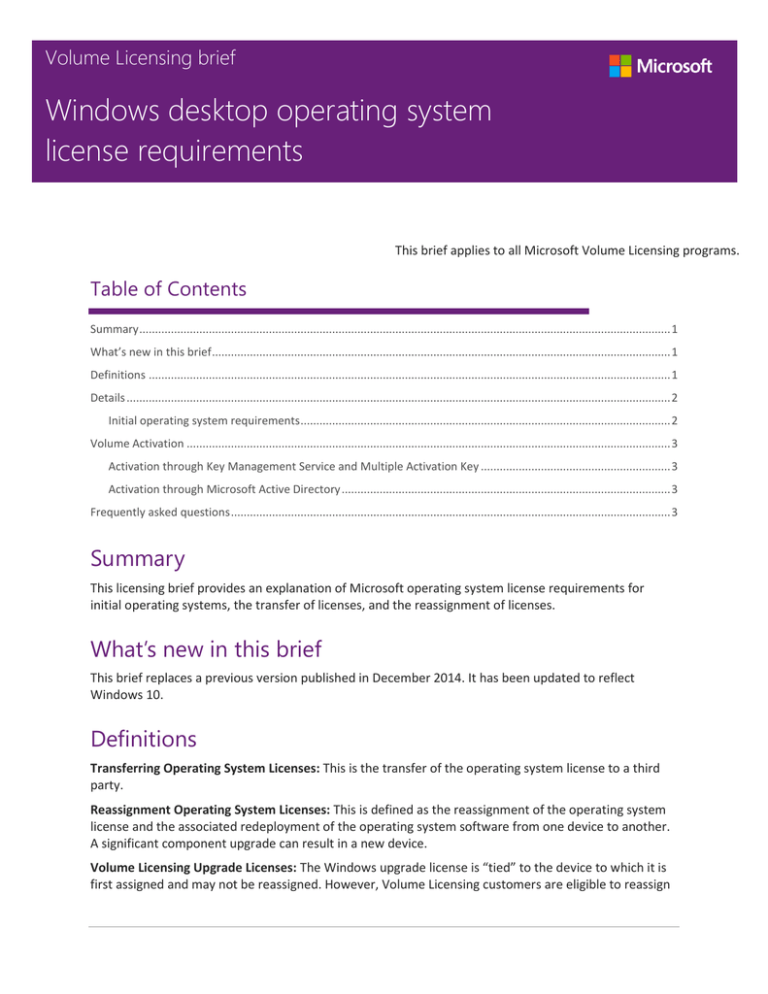
Volume Licensing brief
Windows desktop operating system
license requirements
This brief applies to all Microsoft Volume Licensing programs.
Table of Contents
Summary ........................................................................................................................................................................ 1
What’s new in this brief ................................................................................................................................................. 1
Definitions ..................................................................................................................................................................... 1
Details ............................................................................................................................................................................ 2
Initial operating system requirements ..................................................................................................................... 2
Volume Activation ......................................................................................................................................................... 3
Activation through Key Management Service and Multiple Activation Key ............................................................ 3
Activation through Microsoft Active Directory ........................................................................................................ 3
Frequently asked questions ........................................................................................................................................... 3
Summary
This licensing brief provides an explanation of Microsoft operating system license requirements for
initial operating systems, the transfer of licenses, and the reassignment of licenses.
What’s new in this brief
This brief replaces a previous version published in December 2014. It has been updated to reflect
Windows 10.
Definitions
Transferring Operating System Licenses: This is the transfer of the operating system license to a third
party.
Reassignment Operating System Licenses: This is defined as the reassignment of the operating system
license and the associated redeployment of the operating system software from one device to another.
A significant component upgrade can result in a new device.
Volume Licensing Upgrade Licenses: The Windows upgrade license is “tied” to the device to which it is
first assigned and may not be reassigned. However, Volume Licensing customers are eligible to reassign
Windows desktop operating system license requirements
Software Assurance coverage to an appropriately licensed replacement device. The replacement device
must be licensed to run the latest version of the desktop PC operating system available as of the date of
the reassignment. In addition, the customer must remove from the original device any desktop PC
operating system upgrades that were installed under the transferred Software Assurance coverage.
Customers may not otherwise separate Software Assurance coverage from the underlying license for
which it is ordered.
Details
Initial operating system requirements
You cannot acquire full Windows operating system licenses for desktop PCs through Microsoft Volume
Licensing programs. You can only acquire upgrade licenses. You must first have licensed and installed a
qualified full desktop PC operating system on your device before your PC is eligible for the Windows Pro
upgrade license or Windows Enterprise upgrade license through Microsoft Volume Licensing programs.
You can acquire full Windows operating system licenses for desktop PCs preinstalled on a new PC by an
original equipment manufacturer (OEM).
Transfer of a Windows License
Reassignment of a Windows License
OEM Licenses
The OEM license for the Windows
desktop PC operating system is “tied”
to the device on which software is first
installed. Accordingly, customers may
not transfer the OEM license to a third
party without that device. As long as
the license and device remain together,
no limit exists for the number of times
they may be transferred.
The OEM license for the Windows
operating system for desktop PCs is
“tied” to the device on which it is
preinstalled. Accordingly, customers
may not reassign it to a different device.
Volume
Licensing
Upgrade
Licenses and
Microsoft
Software
Assurance
The Volume Licensing Upgrade license
for the Windows desktop PC operating
system is “tied” to the device on which
the software is first installed.
Accordingly, customers may not
transfer the Volume Licensing operating
system license without that device.
Other restrictions apply to the transfer
of Volume Licensing licenses to third
parties. Customers should refer to their
agreements for details.
The assignment of Licenses for the
desktop operating system (excluding
Windows VDA) is permanent, with the
following exception as provided through
Software Assurance (SA):
August 2015
You may reassign SA coverage from the
original device to a replacement device,
but not on a short-term basis (i.e., not
within 90 days of the last assignment),
as long as (1) you have licensed and
installed on the replacement device the
latest version of a Qualifying Operating
System and you reassign the underlying
Windows Enterprise license to the same
replacement device, and (2) you remove
any related operating system upgrades
from the original device.
2
Windows desktop operating system license requirements
Retail full
package
product (FPP)
Licenses
(Windows 7
and prior
versions only)
The FPP license for the Windows
desktop PC operating system may be
transferred once to a third party.
However, the software must be
uninstalled and completely removed
from the licensed device when the
license is transferred without that
device.
The FPP license for the Windows
desktop PC operating system may be
reassigned to another device. However,
the software deployed under that
license must be uninstalled and
completely removed before the license
is reassigned to another device.
Volume Activation
Windows product activation is a set of technologies enabling customers to confirm that their copy of
Windows is properly licensed. Product activation is required for all editions of Windows 8 (or later
versions).
Volume Activation allows enterprise customers to automate the activation process and make it
transparent to users. Volume Activation applies to computers that are covered under a Volume
Licensing program, and for customers using Volume Licensing media that were first introduced with
Windows Vista and have since been enhanced. It is used strictly as a tool for activation, and it is not tied
to license invoicing or billing.
Activation through Key Management Service and Multiple Activation Key
Key Management Service (KMS) allows organizations to activate computers within customer
environment through an internally hosted service, and Multiple Activation Key (MAK) activates
computers on a one-time basis by using the hosted activation services provided by Microsoft. Customers
can use either or both key types to activate computers in their environments.
Activation through Microsoft Active Directory
During Active Directory-based activation, any computers connected to the domain and running
Windows 8 (or later versions) or Windows Server 2012 (or later versions) will activate automatically and
transparently during computer setup. These clients stay activated as long as they remain members of
the domain and maintain periodic contact with a domain controller.
Frequently asked questions
1. Can a Volume Licensing customer purchase new devices that do not have an operating system
preinstalled, and license the Windows operating system through Volume Licensing?
No. All new PCs should be purchased with the Windows operating system preinstalled by the
original equipment manufacturer (OEM).
Microsoft Volume Licensing programs are not a source for full licenses for the Windows operating
system. These programs offer only upgrade licenses for the Windows desktop PC license. A
customer using the Volume Licensing Windows desktop PC operating system media to install a full
operating system is not legally licensed for desktop PC operating system software if they acquire a
PC that does not have a licensed copy of the software preinstalled. Using that same operating
August 2015
3
Windows desktop operating system license requirements
system media, they are also not legally licensed if they acquire the Volume Licensing upgrade license
without having a licensed copy of a qualifying desktop PC operating system installed on their device.
2. Scenario: A customer has an older device that came preinstalled with a licensed copy of
Windows 7 Professional but was upgraded to Windows 10 Pro using a Windows 10 Pro Upgrade
license acquired through their Volume Licensing program. If the customer decides to donate this
device to a charity, can they remove the newly installed Windows 10 Pro software from that
device and transfer the license to a different device within their organization?
No. Under Microsoft Volume Licensing programs, operating system licenses are tied to the device to
which they are first assigned. If a customer acquires a current Windows desktop PC operating
system upgrade license through Microsoft Volume Licensing programs and assigns that license to
and installs the desktop PC operating system upgrade on a device, the license is then tied to that
device. The customer cannot reassign the license to another device, regardless of whether or not
the desktop PC operating system software is removed from the original device.
3. A Volume Licensing customer is replacing an older PC and wants to order a new PC without a
desktop PC operating system and install the Windows operating system using their Volume
Licensing media. Can they do this? What if they order a Volume Licensing upgrade for that new
PC?
Volume License media can be used to deploy software only to licensed desktop PCs. A customer
cannot acquire an initial or “full” Windows desktop PC license through any Microsoft Volume
Licensing program. The Windows desktop PC operating system upgrade license is for upgrades only.
To be eligible for the Windows upgrade license through Volume Licensing, customers must first
acquire a full license for a qualifying operating system preinstalled by an OEM.
4. Where are the descriptions of the Volume Licensing upgrade license qualifying desktop PC
operating system licenses?
The Product Terms provides the list of operating systems that qualify a customer to purchase the
Windows desktop PC operating system upgrade license in Volume Licensing.
5. What if I reimage a PC with Windows Enterprise under Software Assurance and the Windows
Software Assurance coverage expires or the licensed user (in the case of Windows Software
Assurance per User) leaves the company?
You are required to revert the PC back to its original licensed operating system.
© 2015 Microsoft Corporation. All rights reserved.
This document is for informational purposes only. MICROSOFT MAKES NO WARRANTIES, EXPRESS OR IMPLIED, IN THIS DOCUMENT. This information
is provided to help guide your authorized use of products you license; it is not your agreement. Your use of products licensed under your volume
license agreement is governed by the terms and conditions of that agreement. In the case of any conflict between this information and your agreement,
the terms and conditions of your agreement control. Prices for licenses acquired through Microsoft resellers are determined by the reseller.
August 2015
4


